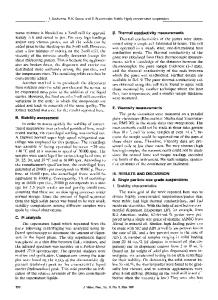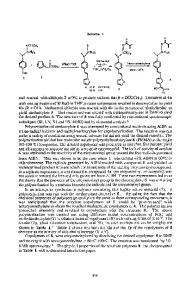Highly Active and Thermally Stable Ctlromophores and Polymers for Electro-Optic Applications
- PDF / 522,167 Bytes
- 9 Pages / 414.72 x 648 pts Page_size
- 82 Downloads / 305 Views
ACTIVE AND
THERMALLY
STABLE
CtlROMOPHORES
AND
POLYMERS FOR ELECTRO-OPTIC APPLICATIONS ALEX K-Y. JEN*1, TIAN-AN CHEN 1 , VARANASI PUSHKARA RAO], YONG-MING CA 11, YUE-JIN LIUt, KEVIN J. DROST', ROBERT M. MININNIt,
LARRY
R.
3 3 DALTON 2 , PETER BEDWORTH AND SETH R. MARDER ,4 1. ROI Technology, 2000 Cornwall Road, Monmouth Junction, NJ 08852. 2. Loker Hydrocarbon Research Institute, University of Southern California, Los Angeles, CA 90089-1062 3. Beckman Institute, California Institute of Technology, Pasadena, CA 91125 4. Jet Propulsion Laboratory, California Institute of Technology, Pasadena, CA 91109.
ABSTRACT We have developed two new classes of highly active and thermally stable nonlinear optical (NLO) chromophores based on the use of efficient thiophene conjugating units, a N,N-diphenylamino electron-donating group, and a 1,1'-dicyanovinyl substituted electronaccepting group. We have also developed a facile and generally applicable method to functionalize NLO chromophores onto high temperature polymers to demonstrate both high electro-optic (E-O) coefficients and long-term alignment stability at 100 °C. INTRODUCTION Organic polymeric electro-optic (E-O) materials have attracted significant attention because of their potential use as fast and efficient components of integrated photonic devices. 1 ,2 However, the practical application of these materials in optical devices is somewhat limited by the stringent material requirements imposed by the device design, fabrication processes and operating environments. Among the various material requirements,3 the most notable ones are large electro-optic coefficients (r33) and high thermal stability. The design of poled polymeric materials with high electro-optic activity (r33 ) involves the optimization of the percent incorporation of efficient (large Pp) second order nonlinear optical (NLO) chromophores into a polymer matrix and the effective creation of poling-induced noncentrosymmetric structures. The factors that affect the material stability are a) the inherent thermal stability of the NLO chromophores, b) the chemical stability of the NLO chromophores during polymer processing, and c) the long-term dipolar alignment stability at high temperatures. Although considerable progress has been made in achieving these properties, 4 organic polymeric materials suitable for practical E-O device applications are yet to be developed. This paper highlights some of our approaches in the optimization of molecular and material nonlinear optical and thermal properties. RESULTS AND DISCUSSION Second order hyperpolarizabilities of compounds I - 11 were determined using an5 electric field induced second harmonic generation (EFISH) technique described elsewhere. To minimize possible resonance enhancement which would exaggerate the measured nonlinear responses, measurements were performed at a fundermental wavelength of 1.907 4im. At this juncture, no attempts were made to separate P from P-t which requires the evaluation of the ground state dipole moment (t). The EFISH data obtain
Data Loading...











